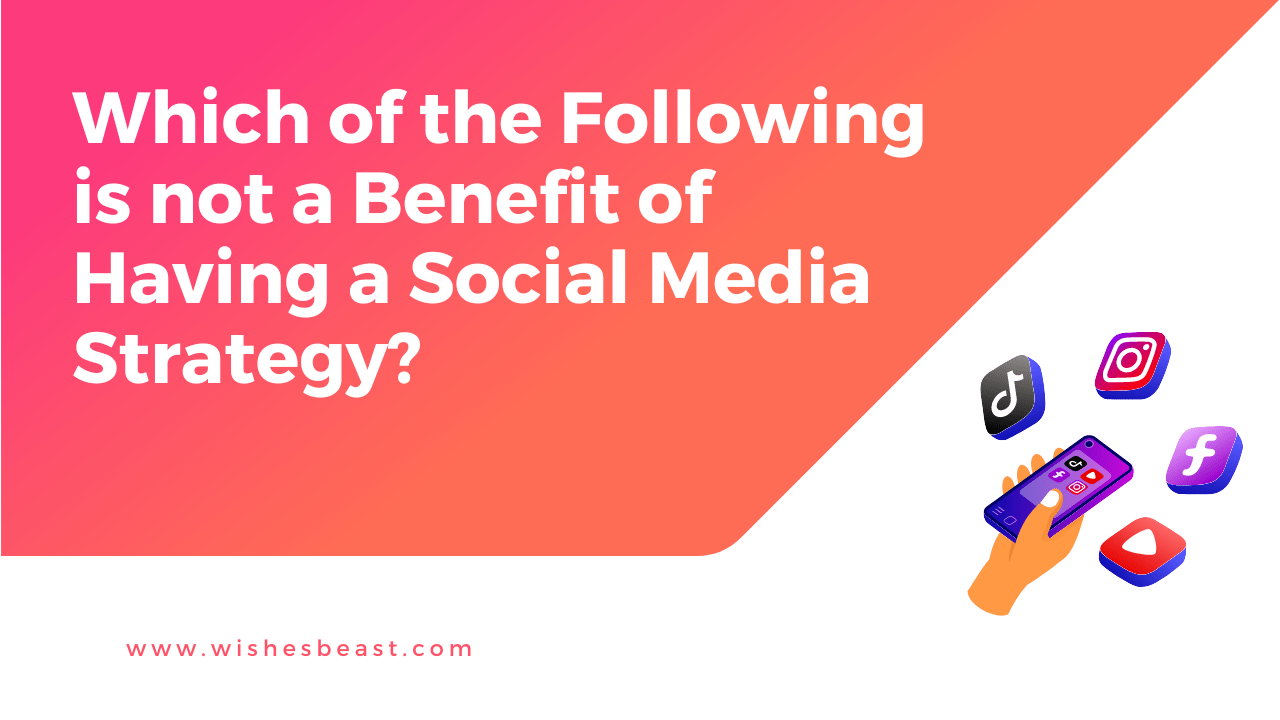In today’s digital age, a well-executed social media strategy has become a cornerstone for businesses aiming to thrive in the online realm. The vast reach and influence of social media platforms provide numerous benefits for companies looking to connect with their target audience, boost brand visibility, and drive growth. However, it is essential to recognize that while a social media strategy can yield remarkable results, it is not without its limitations and potential drawbacks. In this article, we will explore “which of the following is not a benefit of having a social media strategy?”, and shed light on the one aspect that does not contribute positively to a business’s online success.
Why is a Social Media Strategy Important?

A comprehensive social media strategy serves as a roadmap for businesses to navigate the ever-evolving digital landscape effectively. It enables companies to align their online efforts with their broader goals and objectives, empowering them to make data-driven decisions, engage their audience, and stay ahead of the competition.
Benefits of Having a Social Media Strategy
- Enhanced Brand Visibility: A well-implemented social media strategy increases a business’s online visibility, allowing it to reach a broader audience and establish a strong digital presence. By leveraging platforms like Facebook, Instagram, Twitter, and LinkedIn, companies can showcase their products or services, connect with potential customers, and build brand recognition.
- Targeted Audience Engagement: A social media strategy enables businesses to connect with their target audience on a more personal level. By understanding the preferences, interests, and behaviors of their customers, companies can create tailored content, initiate meaningful conversations, and cultivate a loyal community around their brand.
- Increased Website Traffic and Conversions: Social media platforms act as a gateway to direct traffic to a business’s website. A well-crafted social media strategy utilizes engaging content, enticing visuals, and strategic calls-to-action to drive users to the company’s online presence, leading to increased website visits, sales, and conversions.
- Effective Brand Storytelling: Social media provides a powerful platform for businesses to tell their unique brand story. Through compelling visuals, captivating videos, and authentic narratives, companies can captivate their audience, foster emotional connections, and differentiate themselves from competitors.
- Real-time Customer Feedback: Having a social media strategy allows businesses to gather valuable insights through customer feedback. By actively listening to their audience, companies can identify areas for improvement, address customer concerns promptly, and foster trust and credibility.
- Competitive Advantage: In today’s hyper-competitive market, a social media strategy can give businesses a distinct edge. By staying informed about industry trends, monitoring competitor activities, and leveraging analytics, companies can refine their strategies and stay one step ahead of the competition.
Consequences of Neglecting a Social Media Strategy

While the benefits of a well-defined social media strategy are evident, neglecting or not having one in place can lead to certain limitations and missed opportunities for businesses. Here is the one aspect that does not contribute positively to a business’s online success:
Limitation: Inconsistent Brand Messaging

Without a social media strategy, businesses may struggle to maintain consistent brand messaging across different platforms. Inconsistency can dilute the brand’s identity, confuse the audience, and hinder brand recall. A cohesive and unified brand message is crucial for building trust, fostering loyalty, and establishing a strong brand image. Neglecting this aspect can result in fragmented communication, reducing the impact and effectiveness of a business’s social media presence.
- Brand Guidelines: Clearly define brand guidelines that encompass the company’s values, tone of voice, visual identity, and messaging. These guidelines should be consistently applied across all social media platforms to create a cohesive brand experience.
- Content Calendar: Develop a content calendar that outlines the type of content, posting frequency, and platform-specific strategies. This ensures that businesses maintain a consistent presence and deliver relevant and engaging content to their audience.
- Monitoring and Analysis: Regularly monitor and analyze the performance of social media campaigns. By leveraging data and insights, businesses can identify areas of improvement, adjust their strategies, and ensure consistent messaging and engagement.
- Employee Training and Collaboration: Educate employees on brand guidelines, voice, and messaging to ensure a unified approach across the organization. Encourage collaboration and communication between teams responsible for social media management to maintain consistency.
- Customer Feedback and Engagement: Actively listen to customer feedback and engage with the audience on social media platforms. This helps businesses identify any inconsistencies, address concerns, and align messaging with customer expectations.
Overcoming the Limitations: The Path to Success

To overcome the limitations of inconsistent brand messaging, businesses can implement the following strategies:
- Clear Brand Identity: Establishing a clear and cohesive brand identity is essential. This involves defining the brand’s values, mission, and unique selling propositions. By having a well-defined brand identity, businesses can ensure that their messaging remains consistent across social media platforms.
- Centralized Content Creation: Creating a centralized system for content creation and management can help maintain consistent brand messaging. This involves having a dedicated team or individual responsible for overseeing content creation, ensuring that all content aligns with the brand’s guidelines and values.
- Content Approval Process: Implementing a content approval process can be beneficial, particularly for businesses with multiple team members or departments involved in social media management. This process ensures that all content is reviewed and approved before being published, reducing the chances of inconsistent messaging.
- Social Media Style Guide: Developing a social media style guide can provide clear instructions and guidelines for creating content on various platforms. This includes recommendations for tone of voice, language usage, visual elements, and branding guidelines. A style guide acts as a reference tool for content creators, helping them maintain consistency across all social media channels.
- Regular Auditing: Conducting regular audits of social media profiles and content can help identify any inconsistencies and ensure alignment with the brand’s messaging. Audits can include reviewing content, checking profile information, and assessing visual elements. This process allows businesses to make necessary adjustments and maintain a cohesive brand image.
- Training and Education: Providing training and education to employees involved in social media management is crucial. This ensures that everyone understands the brand’s messaging, values, and guidelines. Training sessions can cover topics such as social media best practices, content creation, and brand consistency.
- Engaging with the Audience: Actively engaging with the audience on social media platforms can help reinforce consistent messaging. Responding to comments, addressing customer inquiries, and participating in conversations demonstrate a brand’s commitment to its messaging and values. This engagement also provides an opportunity to clarify any misconceptions and reinforce the brand’s identity.
- Data Analysis and Optimization: Continuously analyzing social media data and metrics can provide valuable insights into the effectiveness of messaging. By monitoring engagement, reach, and conversions, businesses can identify patterns, trends, and areas for improvement. This data-driven approach allows for constant optimization of social media strategies to ensure consistent and impactful messaging.
Frequently Asked Questions
What is a social media strategy?
Answer: A social media strategy is a well-defined plan outlining how a business or individual intends to use social media platforms to achieve specific goals and objectives. It includes tactics, content plans, and target audience considerations.
What are the benefits of having a social media strategy?
Answer: A social media strategy offers several benefits, including increased brand visibility, improved audience engagement, better content planning, enhanced communication, and the ability to measure and analyze performance metrics.
Can you list some common benefits of having a social media strategy?
Answer: Certainly! Common benefits include building brand awareness, driving website traffic, fostering customer loyalty, increasing lead generation, and providing a structured approach to social media marketing.
Which of the following is not a benefit of having a social media strategy?
Answer: One key aspect that is not a direct benefit of having a social media strategy is immediate sales or revenue generation. While a well-executed strategy can indirectly contribute to sales, its primary focus is on long-term relationship-building and brand growth.
How can a social media strategy impact a business negatively?
Answer: While social media strategies are generally beneficial, they can have negative consequences if not executed correctly. Common pitfalls include alienating audiences with inappropriate content, damaging brand reputation through social media mismanagement, and wasting resources on ineffective strategies that don’t align with business goals.
Also Read: Her Roots Hair Growth Oil: All You Need to Know (2023)
Conclusion: Which of the Following is not a Benefit of Having a Social Media Strategy?
While a well-defined social media strategy offers numerous benefits for businesses, it is crucial to address and overcome the limitations associated with inconsistent brand messaging. By implementing strategies such as clear brand identity, centralized content creation, content approval processes, social media style guides, regular audits, training and education, engaging with the audience, and data analysis, businesses can establish a strong and consistent brand presence across social media platforms. Overcoming these limitations leads to enhanced brand recognition, increased customer loyalty, and sustainable growth in the digital landscape. By embracing a consistent brand messaging strategy, businesses can effectively communicate their values, engage with their audience, and achieve long-term success in the competitive world of social media marketing.

Harold Ayres, a captivating wordsmith and seasoned blogger, weaves tales that transport readers to worlds unknown. With his keen insight and vivid storytelling, Harold’s literary prowess captivates hearts and minds, leaving an indelible mark on the literary landscape.

